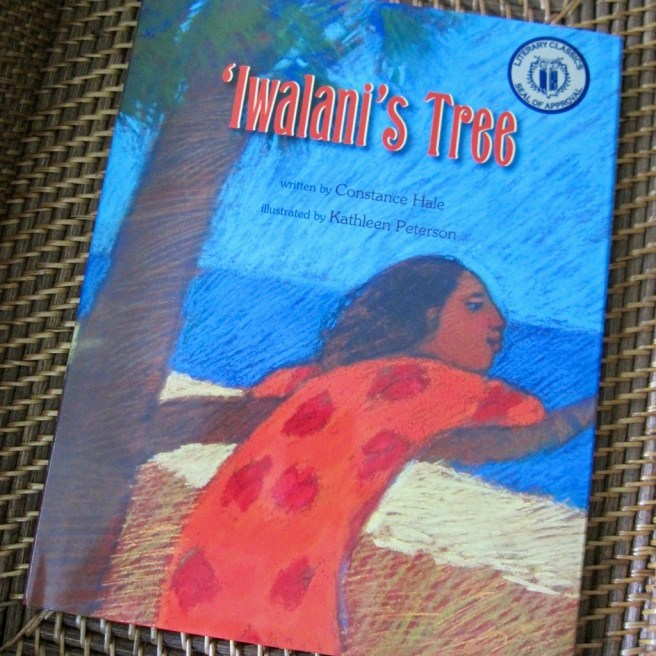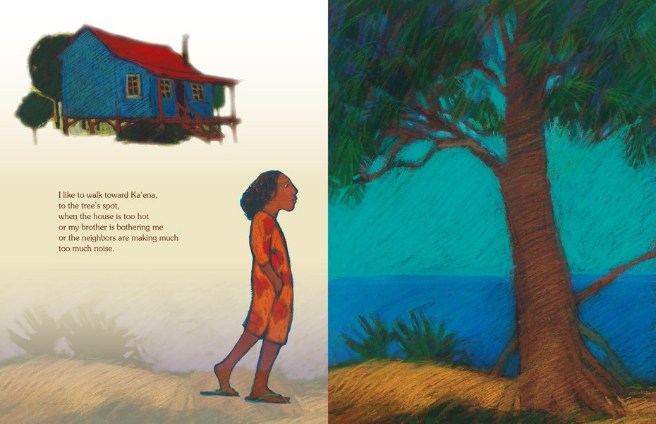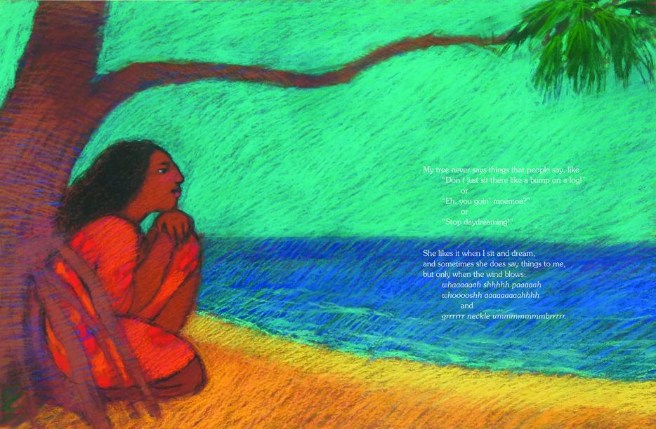
Were you a daydreamer when you were growing up? Was there a special place you frequented to be alone with your thoughts?
Told as a gentle free verse poem, ‘Iwalani’s Tree is an enchanting story about a girl from O’ahu’s North Shore who has a special bond with an ironwood tree that’s her secret friend, muse, elder, and solace.
I like to lean on a low branch of a tree
that stands way way down the beach,
toward Ka’ena,
just on the spot
where the land becomes sand.
Some people call it a paina,
some call it an ironwood.
It has fuzzy brown bark,
a trunk strong and good,
and long willowy needles
that whisper in the wind.
She goes on to explain that the tree is a kind of refuge, a place to go “when the house is too hot/or my brother is bothering me/or the neighbors are making much too much noise.” She leans against its trunk and plays beneath its branches, carrying on conversations with the tree, who never demands or judges, only listens.

In the tree’s presence, ‘Iwalani’s dreams take flight. What better place than in the cool shade, with only the “Sounds of the sea and the sand and the waves and the wind,” the tree whispering as the wind tickles its needles?
Sometimes, when there’s a brisk wind (he makani Mālua), the tree “yowls scary sounds.” Then, ‘Iwalani also hears the mongoose, owl, hawk, and wild boar. She asks the tree what it does all day and night, and the tree, who “speaks” only when the wind blows, tells ‘Iwalani she dreams — after all, she has “legs to rrrrun down the beach/and arms to rrrreach for the sea.” ‘Iwalani thinks that’s silly, but soon changes her mind.
One night there’s a big storm and ‘Iwalani wonders whether her tree will be able to withstand the harsh conditions.
Huge white waves smash onto the sand.
A howling wind tears the leaves off trees.
Lightning cracks the sky open like a coconut.
The next morning ‘Iwalani frantically races down the beach, relieved to find her tree still standing, but something has changed. So much sand has been pulled away, that the tree’s big roots are exposed. They resemble “giant knees and feet.” Having lost so much of its needles, the tree’s branches now resemble “giant elbows and fingers” stretching toward the sea.
So the tree was right all along; it really can have legs to run down the beach and arms to reach for the sea! ‘Iwalani continues to observe how the tree changes with each succeeding storm, only too pleased to while away the hours in its company, dreaming and dreaming.

Communing with nature affords ‘Iwalani many peaceful hours of introspection and a fresh appreciation of the world around her.
Hale’s soothing lyrical verse (which seamlessly incorporates a few Hawaiian words), and Peterson’s lush and evocative jewel-toned illustrations, celebrate Hawai’i’s natural beauty and the ongoing reverence locals have for ocean and shore. I like how the artist’s pastel strokes give the pictures a marvelous texture. This story is also an ode to the child’s imagination, the power of dreams, and the freedom to be oneself.
The lulling, meditative tone makes this a nice bedtime book. In a noisy, competitive world where children are sometimes over-scheduled and raised to believe bigger, faster, and flashier are better, this quiet, contemplative story offers an opportunity for parent and child to slow down and reflect.

The tree’s branches bend and lean
over the beach.
Her shadow makes a pool of cool,
and her fallen needles float out
like Mr. Tanaka’s great green net.
A good introduction to free verse with its sensory detail and poetic devices such as personification, imagery, rhyme, rhythm, onomatopoeia, assonance and alliteration, ‘Iwalani’s Tree also has great curriculm connections with science and geography. The author offers teaching guides for each of these disciplines at her website.
I especially enjoyed reading this story, since it transported me to my warm and friendly home state. I could just about feel those gentle trade winds caressing my cheek and hear the tree whispering in the wind:
whaaaaaah shhhhh paaaaah
whooooshh aaaaaaaaahhhh

Quite hypnotic; it was easy falling under this story’s magic spell. I definitely felt calmer and more centered after reading it, and recommend it to those desiring a tranquil Hawaiian story with universal themes. Back matter includes information about the ironwood, legends about the ironwood and Ka’ena Point, and a pronunciation guide for the Hawaiian words used in the text. Don’t miss this rare gem!
*
‘IWALANI’S TREE
written by Constance Hale
illustrated by Kathleen Peterson
published by BeachHouse Publishing, September 2016
Picture Book for age 4-8, 32 pp.
*Literary Classics Seal of Approval
**Study Guides for Poetry, Science and Geography available here.
*
 Our fearless PF leader Mary Lee Hahn is hosting the Roundup at A Year of Reading. Drift over and check out the full menu of poetic goodness being served up in the blogosphere this week. Happy Weekend!
Our fearless PF leader Mary Lee Hahn is hosting the Roundup at A Year of Reading. Drift over and check out the full menu of poetic goodness being served up in the blogosphere this week. Happy Weekend!
*Interior spreads posted by permission of the publisher, text copyright © 2016 Constance Hale, illustrations © 2016 Kathleen Peterson, published by BeachHouse. All rights reserved.
**Please Note: Some of the colors in the illustrations shown here differ from the book.
Copyright © 2017 Jama Rattigan of Jama’s Alphabet Soup. All rights reserved.


As a child, I had a tree that was my “secret friend, muse, elder, and solace.” It was not nearly as “exotic” as this one. Perhaps “exotic” is only a point of view, though? Sounds like a marvelous book, and I’m always looking for mentor texts that show how free verse is very poetic. Thanks!
LikeLike
Nice to hear that, Mary Lee. I think all kids should have a special place — a safe haven they can call their own to daydream to their heart’s content. 🙂
LikeLike
Such a lovely book. I love the illustrations as well. This reminds me of how I used to have this tree I’d climb on when i was growing up, it was eventually cut down. Thanks for sharing this book.
LikeLike
Nice to hear you also had a favorite tree, Iphigene. This is a lovely book, a nice change from all the short funny stuff that usually gets all the attention these days.
LikeLiked by 1 person
This looks lovely, Jama. The illustrations are so bright and vivid. I will put it in our library’s suggest-a-title program since they don’t yet have it–thank you! 🙂
LikeLike
Thanks for requesting it at your library, Maria. As I noted at the bottom of the post, some of the colors as they appear here aren’t true to the original book. This sometimes happens — don’t know why.
LikeLike
It sounds fantastic, Jama. I can’t wait to read it!
LikeLike
Hope you get to see it soon, Kiesha!
LikeLike
What a beautiful book! I now want to go climb a tree–or at least dwell in my memories of the pine tree in the corner of my backyard that was my refuge and place for reflection.
LikeLike
I wasn’t a tree climber growing up. Obviously I missed the chance for a unique refuge. Nice to hear about your pine tree, Kay. 🙂
LikeLike
Yes, I was definitely a daydreamer. I still am.
I think it’s great to have a new picture book that takes place in Hawaii. Some folks in our country forget that it’s a state!
LikeLike
Hear, hear! It’s a pitiful state of affairs when a current AG disregards its importance. Hello, Pearl Harbor. Hello, President Obama.
LikeLike
The book looks – and sounds – beautiful!
LikeLike
It’s a lovely, quiet book, something you don’t see that often these days.
LikeLike
This is like the sway of a hammock, and the scratch board art is perfect for the soothing words. What a lovely concept — I had so many little places I wanted to withdraw to, but no ONE special place. Now I need a tree…
*wanders off, checking the backyard*
LikeLike
“sway of a hammock” is a wonderful way of describing how this book feels.
LikeLike
I had a special tree at my grandparents’ home, stayed in it reading and daydreaming so many times. I’ve returned to that little town to see if it was still there, and it is, but it’s now older of course, and enormous! I love seeing the different connections that those of us on the mainland would not make, Jama, but of course you would, like “Lightning cracks the sky open like a coconut.” and “like Mr. Tanaka’s great green net.” Thank you for sharing all about this new book!
LikeLike
It’s nice to see those island-type frame of references, isn’t it? I miss that Hawaiian flavor.
LikeLike
What a beautiful review. Thank you for a lovely introduction to this book. I could use a slice of Hawaiian beach right now!
LikeLike
The sound of the ocean is very soothing . . .
LikeLike
Looks lovely! Ruth, thereisnosuchthingasagodforsakentown.blogspot.com
LikeLike
It is!
LikeLike
“Her shadow makes a pool of cool” is fabulous. I just put a request in for this gorgeous book at my school and town library. Thank you for sharing it with us!
LikeLike
Glad you’ve requested this one. Enjoy it!!
LikeLiked by 1 person
This sounds like a wonderful read for kids. As you were describing and quoting from it, I found myself remembering how I reacted to Anne of Green Gables and other books by L. M. Montgomery, whose characters modeled an awareness of their surroundings that set me on that path. I so agree that kids these days need books with margin–space to notice, think, dream, imagine.
LikeLike
I love the Anne books too!
LikeLike
Jama, thank you for taking me back to my youth and the willow tree that housed my dreams. This books sounds like it would take many children to a place of quiet and reflection. “Communing with nature affords ‘Iwalani many peaceful hours of introspection and a fresh appreciation of the world around her.” When we want to introduce diverse books into the classroom, I think this one would be a good choice. Long Island children have very little knowledge of life in Hawaii.
LikeLike
This book is a good choice for all the reasons you mentioned. I was happy to stumble upon it. 🙂
LikeLike
Sounds like a very soothing book, maybe nice to read to settle down before sleep?
Wonderful images and vocabulary.
LikeLike
Yes, it would make nice bedtime reading. 🙂
LikeLike
I like how the tree is a threshold, on the meeting point of land and sand, as the role of the tree is, where the imagination meets reality. We all need a spot there, to easily access one state or the other. The art is gorgeous, the pastel colors really invoke Hawai’i.
LikeLike
Cool observation, Brenda. Yes, the tree is indeed a threshhold between imagination and reality!
LikeLiked by 1 person
I have an armchair that works for me that way. I used to prefer a path through a swamp, where boards would squelch and slurp. Cattails would hide me, frogs leap out of my path, and my steps always took me to magical places. An abandoned apple orchard was my imagination’s courtyard.
LikeLiked by 1 person
Such a nice respite from the continuous flow of new picture books that frighten or overstimulate their audience.
LikeLike
Respite is a good word to describe this book. The quiet pause is so important.
LikeLike
How beautiful! I have felt affinity for certain trees I’ve known in my life — it’s a special friendship and a kind of love story, isn’t it? Thank you, Jama! xo
LikeLike
Yes, a very special friendship! Thanks for visiting, Irene. 🙂
LikeLike
Gorgeous, Jama – the lyrical language, luminous colors, and your thoughts! Thank you for sharing. (I was definitely a daydreamer with a few special trees; I named one, too! It was the “Queen Snake Tree” in my backyard in Florida – just a regular pine with a snake-shaped branch reaching out that to me, looked regal.) :0)
LikeLike
Only you would name a tree!
LikeLike
Trees were a refuge for me when I was young. I don’t think there was a single one in my yard I hadn’t figured out how to climb. This book sounds magical, Jama. I feel calmer just having read your review. Thank you for sharing!
LikeLike
I’m surprised at how many of the PF folks sought refuge in special trees. Thanks for stopping by to read — glad you feel calmer now. 🙂
LikeLiked by 1 person
Thanks for reviewing this lovely book, Jama, I definitely would like to spend some time with it. The art is rich and inviting as is the story! When I was a child, I always enjoyed walking through the rain (alone) and actually was comforted by it, it gave me a sense of independence and calm.
Thanks also for this delightful, summery, illustration at the top of your post, it’s charming!
LikeLike
Walking in the rain can be magical and mystical (as long as it isn’t pouring!). Glad you like the header image — it’s fun looking for new ones. 🙂
LikeLike